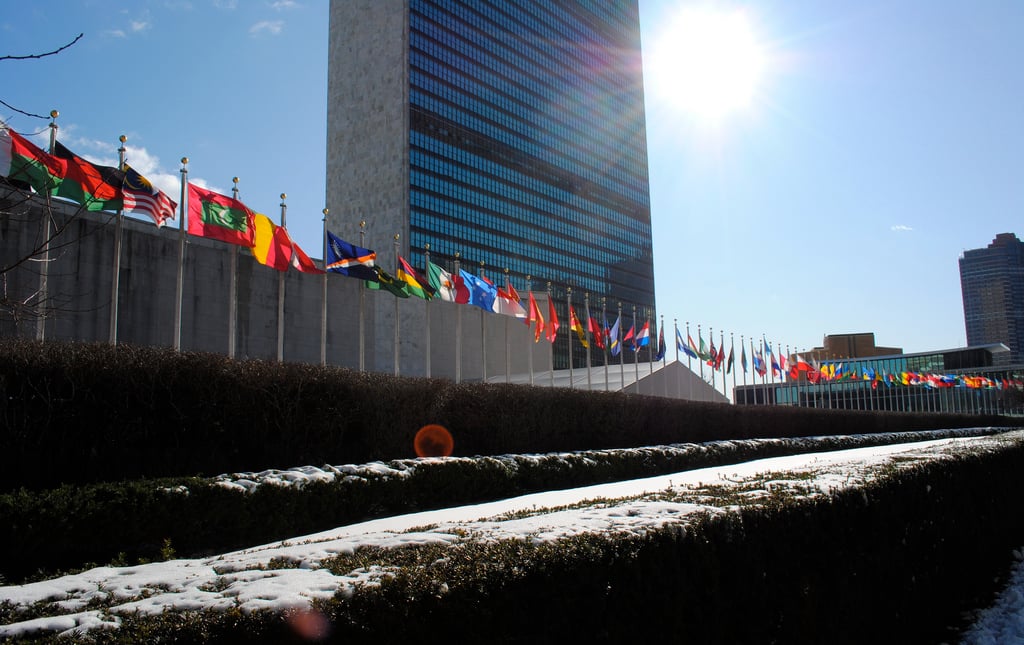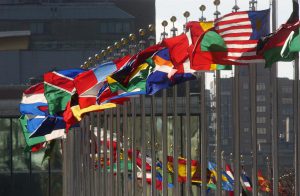Around 170 countries on Friday signed the Paris Climate Agreement, a record number for an international treaty, which the UN says could yield early action and make the deal effective from next year. This would be well before the official start date of 2020.
In order for the treaty to enter into force, at least 55 countries, representing at least 55% of greenhouse gas emissions, need to “ratify, accept, assent or approve” following the April 22 signing ceremony in New York.
Urging swift ratification, UN Secretary-General Ban Ki-moon told global leaders and ministers on Friday that the world is in “a race against time,” referring to all-time high global temperatures, record ice loss and unprecedented levels of greenhouse gases in the atmosphere.
“The era of consumption without consequences is over,” Ban said, adding: “We must intensify efforts to decarbonise our economies.”
Some signatories, such as the EU, are expected to take at least 18 months to put last December’s climate deal into action, as they have yet to decide how its 2030 climate target will be divided up among member states.
Countries such as India and Japan will likely need to get a vote of approval for the Paris Treaty from their respective parliaments.
But some observers are increasingly confident that the process will be speeded up by early approval or assent from large emitters, most notably China and the US, which between them account for around 40% of the world’s output of GHGs.
On Friday China’s Vice Premier Zhang Gaoli said his government would ratify the Paris deal in time for the G20 summit to be held in Hangzhou in September.
Optimism is growing that the Paris Agreement can avoid a lengthy hiatus, despite suggestions that many developing countries should delay signing or ratification to gain leverage with rich countries on issues such as finance.
Getting countries to put pen to paper is the easy part. Much tougher will be ensuring and measuring that countries deliver what they promised at Paris, and whether they can step up their ambition in just a few years.
[The World Resources Institute has created a handy tool that tracks countries’ actions on the Paris Agreement, as has Climate Analytics, with its tracker linked here]
“I think we will have [the Paris Agreement] in effect by 2018,” UN climate chief Christiana Figueres told an event in London last week, adding that the need for urgency was paramount and that deep emissions cuts were at least a decade overdue.
The world is now at “two minutes to midnight,” Figueres said, adding that if the world is to get to “net zero” emissions in the second half of the century, “we would have to peak by 2020”.
She added that a business-as-usual scenario “would have us peaking somewhere between 2025 and 2035,” underlining the need for decisive action much sooner.
Extreme weather events linked with the cyclical El Niño weather phenomenon have given policymakers a foretaste of the disasters expected to become commonplace in a warming world.
Against this backdrop, a meeting this week of the UN’s climate science panel, the International Panel on Climate Change (IPCC), will study the feasibility of cutting emissions so that a rise in average global temperatures can be restricted to 1.5C.
This is the threshold that small island states and most vulnerable countries say is essential for their survival.
Largely at their insistence, the 1.5C threshold was included in the Paris Agreement, but most developed countries, most notably EU member states, have based their proposed emissions cuts on a 2C figure as a more feasible outcome.
Many scientists say that the rate that GHGs have been pumped into the atmosphere makes 1.5C impossible without huge deployment of technologies that can remove GHGs from the atmosphere.
The 2C limit, which is informed mainly by IPCC recommendations published in 2007, would condemn many of the most vulnerable countries to disaster, and emissions cuts proposed by countries in Paris last December are nowhere near deep enough, and put the world on a path to 3-3.5C warming.
According to a report released on Thursday, a 2C outcome – which is in itself a huge challenge – would lead to much higher sea levels that could swamp cities and coastal areas that are home to billions of people .
Moreover, the research from Climate Analytics says that 2C warming would make some parts of the world, particularly the Tropics, uninhabitable because of increasingly extreme heat. Temperatures would likely rise to the point that they would be beyond the capability of humans to endure.
Meanwhile, countries in the Mediterranean, which already have to deal with serious water crises, would endure more frequent droughts.
Climate policy analysts say that if the Paris Agreement is enacted early, a review mechanism or “global stocktake” in 2018 could put countries under increasing pressure to agree deeper, faster carbon cuts.
Another report released on April 21 has outlined the various scenarios that would be required for a rise in global temperatures to be capped at 2C or below.
By the time of a ‘global stocktake’ in 2018, countries will need to come to the table with revised plans for much deeper carbon cuts in most economic sectors after 2020, said a report co-authored by Climate Interactive, a research organisation, and MIT Sloan, a US business school.
Without these deep cuts, it will be increasingly unfeasible to make cuts fast enough after 2030 so that a rise in temperatures is capped at 2C, it added.
“It is like driving to an important meeting. You could get there safely if you leave now. Or you could wait, drive too fast, and risk a horrible accident,” said Andrew Jones of Climate Interactive, one of the co-authors of the report.
“If we improve the Paris pledges now, we can limit warming below 2C. If we wait and only ratchet up pledges post-2030, then we’d have to reduce greenhouse gas emissions at a reckless and costly rate,” he added.
If a majority of major emitters put their commitments (known in UN-speak as Nationally Determined Contributions) into action swiftly this could deliver other big benefits for the UN climate process.
Why much more is needed to avoid catastrophic climate change
Locking in
These include ‘locking in’ the US into the Paris Agreement ahead of a change in the White House early next year, through which a Republican, if elected, could block or try to reverse climate action.
Early ratification or implementation would also send out a strong signal to business and industry that policymakers will work towards deeper emissions cuts over time, underlining the financial risks to investments in fossil fuels and give stronger incentives to low carbon technology such as renewables.
“Those countries who are major emitters are also some of those with most to gain from prompt action to curb the threat of climate change because of the massive impacts it could have, not just on agricultural systems, transport or energy infrastructure but on bottom lines,” said the head of the Carbon Disclosure Project, one of the business groups that signed a letter last week urging early ratification by governments.
Carbon exposure
Many of the world’s biggest companies, central banks, and a G20-appointed ‘task force’, which will report by the end of this year, are investigating the threats to the global financial system if the world doesn’t switch to low carbon investments quickly enough.
A meeting of EU finance ministers in the Netherlands this week proposed ‘stress tests’ for banks that would compel investors to calculate their exposure to extreme weather events and carbon-heavy assets.
Finance
Last weekend, Ban called upon the global insurance industry, which has investment portfolios valued around US$25 trillion, to manage and reduce climate risks more effectively.
This week’s signing ceremony in New York will also be part of a wider effort by the UN to encourage the implementation of the sustainable development goals and the scaling up of climate finance promised by developed countries, and turning the “billions into trillions” that will be needed to deliver a decisive shift from fossil fuels.
Tests
Major tests will follow soon. UN climate talks resume next month, when climate negotiators will start framing how move to move the Paris Agreement forward so that targets can be deepened from 2018 and the necessary climate finance delivered.
In some ways, the UN climate conference in Marrakech, Morocco at the end of this year will be more important than Paris, as the nitty gritty essential to the working of a successful climate agreement will need to be agreed.
‘Messy’
“The positive energy generated (by Paris), along with the mobilisation of both state and non-state actors, is a remarkable achievement,” points out Chatham House in a briefing released on April 21.
It adds: “However, the new regime is somewhat messy and unstandardised, and does not yet add up to a credible ‘below 2C’ pathway.”






